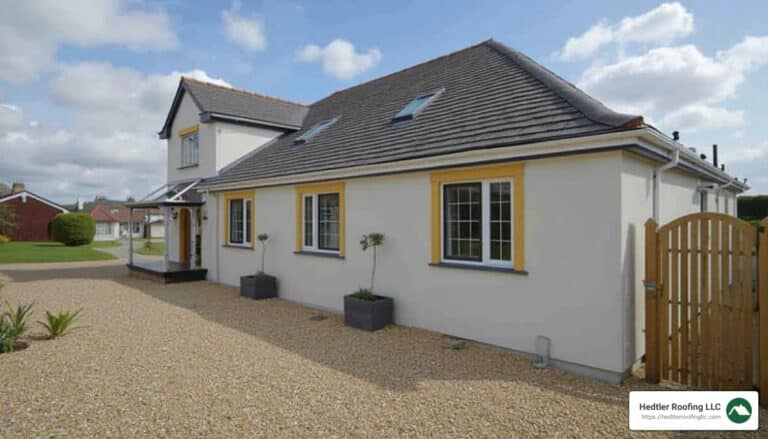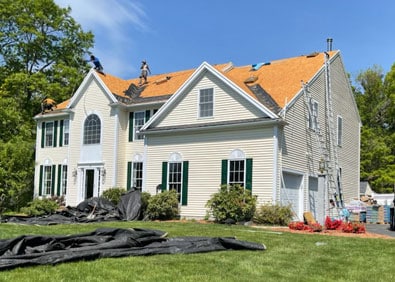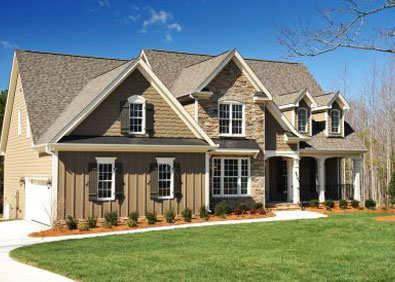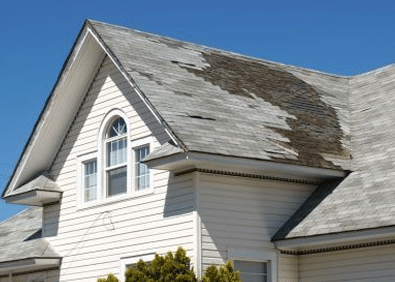
When it comes to new roof construction, many factors come into play. Unlike roof replacement, new roof construction involves building a roof framework from scratch, ensuring optimal compatibility with your home. Here’s what you need to know:
I’m Jason Hedtler, owner of Roof Experts with over 20 years of experience in new roof construction. My team and I are dedicated to providing high-quality, durable roofing solutions custom to homeowners in Massachusetts.

New roof construction basics:
– complete roof replacement
– how to install new shingles on a roof
– new roof installation process
New roof construction isn’t just about slapping some shingles on top of a house. It’s a detailed process that starts from scratch. Unlike roof replacement, which works with an existing framework, new roof construction involves creating the entire roofing system from the ground up.
Definition and Differences from Roof Replacement:
– Roof Replacement: This involves removing an old roof and installing a new one on an existing structure.
– New Roof Construction: This is about building a new roof for a new building. It includes installing the roof’s framework, underlayment, and covering.
Process Overview:
1. Planning: The first step involves detailed planning and strategizing to ensure the roof fits perfectly with the new building.
2. Designing: Architects and engineers work together to design a roof that not only looks good but also performs well.
3. Inspection and Permits: Before any construction begins, inspections are conducted and permits are secured. This ensures the project complies with local building codes and regulations.
Planning and Designing:
– Inspection: A thorough inspection of the building site is necessary to understand the structural needs.
– Permits: Securing the right permits is crucial. In Massachusetts, many towns require building permits for roofing projects. Ignoring this step can lead to fines or forced removal of your new roof.
– Site Preparation: Clear the area, protect landscaping, and set up scaffolding to ensure a safe and efficient work environment.
Choosing the right material for your new roof is vital. Different materials offer various benefits and drawbacks, so it’s important to select one that suits your needs and budget.
Asphalt Shingles:
– Advantages: Cost-effective, easy to install, and low maintenance. Asphalt shingles are versatile and come in various designs to match your building.
– Disadvantages: They may not last as long as other materials and are susceptible to damage in extreme weather.
Metal Roofing:
– Advantages: Highly durable, lightweight, and resistant to elements. Metal roofs can last significantly longer than other types and require less maintenance.
– Disadvantages: Higher initial cost and more challenging installation process. They are also heavier, which could pose complications depending on your building’s structure.
Wood Roofing:
– Advantages: Aesthetically pleasing and can last 20-40 years with proper maintenance. Wood roofs offer a classic look that many homeowners love.
– Disadvantages: Requires more maintenance and can be prone to issues like rot and insect damage if not properly cared for.
Flat Roofing:
– Advantages: Commonly used for commercial properties and modern homes. Flat roofs are easy to maintain, accessible, and provide additional space for solar panels and air conditioning units.
– Disadvantages: May require more frequent maintenance to prevent water accumulation and leaks.
Tile Roofing:
– Advantages: Extremely durable and can last over 50 years. Tile roofs are also resistant to fire and rot.
– Disadvantages: They are heavy and may require additional structural support. Tile roofing is also more expensive and complex to install.
When selecting materials for your new roof construction, consider factors like cost, durability, maintenance requirements, and aesthetic appeal. Consulting with a professional roofing contractor can help you make the best choice for your home.
Let’s dive deeper into the steps involved in new roof construction, from removing the old roof to installing the new one.
The first physical step in new roof construction is removing the old roof. This involves tearing off the existing shingles and underlayment.
Efficiency Tip: Start at the ridge and work your way down. Use a roofing tear-off shovel to pry up the shingles and underlayment. This tool makes the job faster and easier.
Disposal: Renting a dumpster can save you multiple trips to the dump. Throw the old shingles and underlayment directly into the dumpster to keep the work area clean and safe.
Inspection: Once the old materials are removed, inspect the decking for damage. Replace any sections that show signs of rot or water damage. Use a circular saw to cut out damaged areas and replace them with new plywood or OSB of the same thickness. Secure it with 1 1/2″ screws or nails.
Drip Edge: Install the drip edge along the eaves of the roof. This metal strip helps direct water into the gutters, preventing it from seeping into the fascia. Nail it every couple of feet using 1-1/4″ roofing nails.
Underlayment: Lay down the underlayment, which acts as a moisture barrier. In areas with extreme weather, use self-adhesive waterproof underlayment (ice barrier). Otherwise, 15-lb. or 30-lb. felt paper is usually sufficient.
Starter Shingles: Begin by installing starter shingles along the eaves. These seal the gaps and provide a base for the first row of shingles.
Shingles: Lay the first row of shingles, ensuring they overhang the drip edge by about 1/4 inch. Nail each shingle in the nail zone to secure them properly.
Flashing: Install flashing around chimneys, valleys, and dormers. This metal barrier prevents water from seeping into these vulnerable areas.
Ridge Cap: Once both sides of the roof are shingled, install the ridge cap. This is made from shingle tabs and covers the peak of the roof. Nail them down, overlapping each piece, and apply roofing adhesive to the heads of exposed nails to create a waterproof seal.
Inspect the Roof: Walk around the roof to ensure all shingles are securely nailed and no nails are protruding. Check the flashing and ridge cap to make sure they are properly installed.
Cleanup: Remove any remaining debris from the roof and surrounding area. Use a magnet to pick up stray nails from the lawn.
Quote: “A thorough cleanup is the final step to a successful roof installation,” says a Roof Experts expert.
By following these steps, you can ensure a smooth and efficient new roof construction process. Now, let’s look at the cost factors involved in new roof construction.
Understanding the costs involved in new roof construction is crucial for planning and budgeting. Here’s a breakdown of the main cost components: material costs, labor costs, and additional costs.
The choice of roofing material significantly impacts the overall cost. Here are some common options:
Asphalt Shingles
Asphalt shingles are the most popular and affordable option. They are easy to install and come in various colors and styles. However, they require maintenance and don’t insulate well.
Metal Roofing
Metal roofs are durable, energy-efficient, and fire-resistant. They are excellent for cold climates but can be pricier and prone to rusting.
Wood Roofing
Wood shingles or shakes offer a classic look but need more maintenance. They can last 20-40 years with proper care.
Tile Roofing (Clay/Ceramic and Concrete Tiles)
Tile roofs are durable and provide excellent insulation. They are heavy and may require additional structural support.
Labor is one of the most expensive parts of a roof installation. Here’s what you need to know:
Labor Rates
The cost of labor can vary based on the complexity of the roof design and the experience of the contractor. For example, roofs with multiple skylights or chimneys will cost more due to the additional work required.
Seasonal Variations
Roofing costs can increase during peak seasons, such as summer, when demand is high. Planning your project during off-peak times, like late fall or early winter, can save you money.
Complexity of Roof Design
More complicated roof designs will require more labor and time, increasing the overall cost. Simple, flat roofs are generally less expensive to install than steep or multi-faceted roofs.
Several other factors can add to the overall cost of your new roof construction:
Permits and Inspections
Your municipality may require permits and inspections to ensure the roof meets building codes. These fees can vary, so check with your local Planning and Development office.
Structural Repairs
Before installing a new roof, you may need to address existing issues like water damage, rotting wood, or pest infestations. Costs for these repairs can vary widely depending on the severity of the problem.
Removing and Disposing of Old Materials
Removing the old roof and disposing of the materials can add to your expenses. Renting a dumpster can help simplify the cleanup process.
Warranties
Warranties can increase your home’s value and provide peace of mind. They often include regular checkups and minor repairs.
Quote: “Understanding these cost factors helps homeowners budget effectively for their new roof construction,” says a Roof Experts expert.
By considering these factors, you can plan your roofing project more effectively and avoid unexpected expenses. Next, we’ll explore the benefits of professional installation.
When it comes to new roof construction, choosing professional installation over a DIY approach can save you time, money, and a lot of headaches. Here’s why hiring professionals is the best route.
Safety Risks
Roofing is dangerous work. Almost half of all construction-related fatal falls involve roofers. Working at heights without proper training and safety gear increases the risk of accidents.
Potential Damage
Improper installation can lead to serious issues. A poorly installed roof can cause water damage, structural problems, and even mold growth. These issues can be expensive to fix and might not be covered by insurance.
Voided Warranties
Many roofing material manufacturers offer warranties only if the roof is installed by a licensed professional. DIY installation can void these warranties, leaving you responsible for any future repairs.
Skilled Craftsmanship
Professional roofers have the training and experience to do the job right. They can spot potential problems that a DIYer might miss. This ensures that your roof is not only installed correctly but also lasts longer.
Time Savings
A professional crew can complete a roofing project much faster than a DIY effort. This means less time with your home exposed to the elements and less inconvenience for you.
Warranty Protection
Hiring professionals often comes with warranty benefits. These warranties can cover both the materials and the workmanship, giving you peace of mind. If something goes wrong, the roofing company will handle the repairs at no extra cost to you.
Improved Safety
Professional roofers use safety gear and follow strict protocols to minimize risks. This ensures that the job is done safely without putting anyone in harm’s way.
Quality Assurance
A professionally installed roof is more likely to meet local building codes and regulations. This compliance is crucial for the safety and resale value of your home.
By understanding the risks of DIY roof construction and the advantages of hiring professionals, you can make an informed decision that ensures the longevity and safety of your new roof.
Next, let’s move on to some frequently asked questions about new roof construction.
Replacing a 1,000-square-foot roof can cost anywhere between $4,000 and $40,000. The wide range is due to several factors:
Asphalt shingles are typically the most cost-effective roofing material. Here’s why:
While asphalt shingles are budget-friendly, they may not be suitable for extreme climates. For instance, they don’t fare well in areas with frequent temperature fluctuations.
The lifespan of a new roof depends on the material used:
Factors Affecting Lifespan:
By understanding these cost factors and lifespan expectations, you can make a more informed decision when planning your new roof construction.
Next, let’s explore the steps involved in new roof construction.
In summary, new roof construction is a significant investment that can greatly improve the value, safety, and aesthetic appeal of your home. Understanding the process, from planning and designing to material selection and installation, helps ensure the success of your project. Knowing the cost factors, including material and labor costs, is also crucial for budgeting effectively.
The importance of professional installation cannot be overstated. Hiring experts like Roof Experts ensures your roof is installed correctly, safely, and efficiently. Here are a few key reasons why professional installation is essential:
If you’re in Massachusetts and considering a new roof, Roof Experts is your go-to choice. With over 20 years of experience, we specialize in roof installations, replacements, and repairs in the Franklin and Bellingham areas. Our commitment to high-quality workmanship and exceptional customer service sets us apart.
Why Choose Roof Experts?
Ready to get started? Visit our Roof Installations page to request a free inspection or estimate. Let us help you protect your home and improve its value with a new, professionally installed roof.
Your roof is our top priority, and we are dedicated to keeping your home safe and secure with high-quality roofing solutions.
For any further questions or to schedule a consultation, don’t hesitate to contact us. Your satisfaction is our top priority!

Roof Installations

Roof Replacements

Roof Repairs